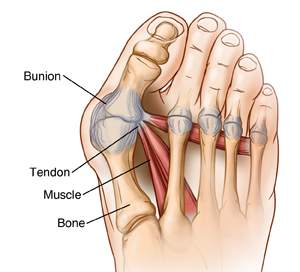Osteotomy and ligament or tendon repair is a type of bunion surgery. A bunion is a bony bump (deformity) at the base of your big toe. This deformity can form when your big toe pushes against your next toe. A bunion can cause pain, swelling, redness, and other symptoms. During this surgery, bone is removed from your toe. The bone or bones are cut and realigned. Nearby tendons and ligaments are made shorter or longer as needed. This allows your big toe to line up (align) correctly.
Preparing for surgery
Follow any instructions from your surgeon.
Tell your surgeon about any medicines you are taking. You may need to stop taking all or some of these before the procedure. This includes:
-
All prescription medicines
-
Over-the-counter medicines, such as aspirin or ibuprofen
-
Street drugs
-
Herbs, vitamins, and other supplements
Follow any directions you are given for not eating or drinking before surgery.
The day of surgery
How long your surgery takes depends on how much of your foot is misaligned and the type of surgery you have. You may go home the same day.
Before the surgery begins
-
An IV (intravenous) line is put into a vein in your arm or hand. This line gives you fluids and medicines.
-
You may be given medicine to help you relax (sedation). To keep you free of pain during the surgery, you may have medicine to block the nerves in your foot. Or you will be given general anesthesia. This puts you into a deep sleep.
During the surgery
-
A cut (incision) is made on your foot to expose the bunion and the tendons and ligaments around it. The tendons and ligaments that are tight are cut (released).
-
The bunion is removed with a bone saw. Your big toe bone or the main bone in your foot is cut and realigned. A pin, screw, or plate (or a combination of these) is used to hold your toe and foot bones together.
-
The nearby tendons and ligaments may be tightened. If there is extra tissue, it's removed, and the ends are stitched (sutured) together. The incision in your skin is then closed with stitches. Your foot is bandaged.
After the surgery
You’ll be taken to a recovery room. You may have medicines to manage pain. You may wear a brace, surgical shoe, or cast to protect your foot while it heals. The surgeon will tell you when you can go home. Have an adult family member or friend drive you.
Recovering at home
After you are back at home, follow any instructions you are given. During your recovery:
-
You may go home with bandages holding your toe in the corrected position. Keeping the toe in this corrected position is critical for correct healing. Don't disturb the dressing unless the surgeon tells you to do so. Follow your doctor's instructions about caring for the bandage.
-
Take pain medicine exactly as directed.
-
To prevent swelling, sit or lie with your leg raised on one or more pillows. Do this for the first
2 to 3 days. -
Follow your surgeon's instructions about putting weight on your foot after the surgery. You may need to use a walker, cane, or crutches for a time.
-
You may wear a brace, surgical shoe, or cast for up to a month or longer. Care for this as instructed. Keep it dry by wrapping it in plastic bags when bathing.
-
Don't do sports or other activities until your surgeon says it’s okay.
-
Care for your incision as instructed.
-
Don't drive until your surgeon says it’s okay.
When to contact your surgeon
Contact your surgeon if any of the following occur:
-
Chest pain or trouble breathing – (
Call 911 ) -
Fever of
100.4 ° F (38 ° C) or higher, or as directed by your surgeon -
Shaking chills
-
Pain that isn’t helped by medicine or rest
-
Increased swelling not helped by raising or icing your foot
-
Signs of infection at any incision site, such as increased redness or swelling, warmth, more pain, or bad-smelling drainage
-
Bleeding through the bandages
-
Symptoms of poor circulation, such as toes that look blue or pale instead of pinkish
-
Numbness that doesn’t go away
-
Any other signs or symptoms indicated by your surgeon
Follow-up
Keep all follow-up appointments with your surgeon. These are to check that you are healing well from the surgery. You may have X-rays to check how the bone is healing. Physical therapy, foot exercises, and other treatments may be discussed at follow-up visits. Full recovery can take up to 6 months. Follow-up visits to your surgeon are sometimes necessary for a year.
Risks and possible complications
-
Infection
-
Bleeding
-
Sensitivity at the incision site for months after the surgery
-
Foot pain that doesn’t go away after surgery
-
Numbness in the foot
-
Only partial relief of symptoms, or no relief of symptoms
-
Return of the bunion
-
Risks of anesthesia (the anesthesiologist will discuss these with you)
-
Poor wound healing
-
Breakage of screws or pins
-
A lot of scarring
Featured in


